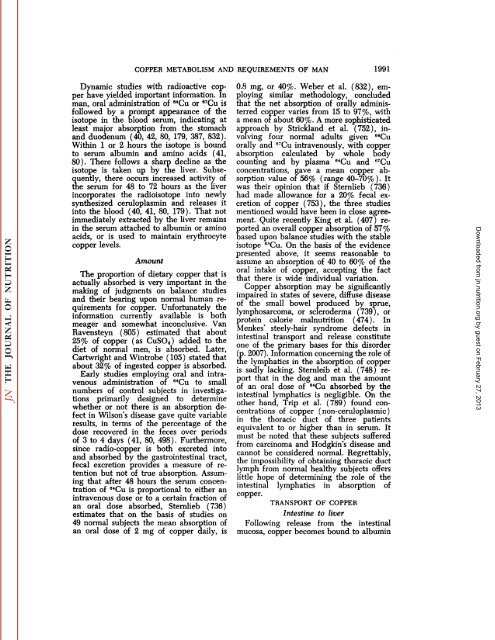conspectus of researchon copper metabolism and requirements
conspectus of researchon copper metabolism and requirements
conspectus of researchon copper metabolism and requirements
Create successful ePaper yourself
Turn your PDF publications into a flip-book with our unique Google optimized e-Paper software.
COPPER METABOLISM AND REQUIREMENTS OF MAN 1991<br />
Dynamic studies with radioactive cop<br />
per have yielded important information. In<br />
man, oral administration <strong>of</strong> 64Cu or 67Cu is<br />
followed by a prompt appearance <strong>of</strong> the<br />
isotope in the blood serum, indicating at<br />
least major absorption from the stomach<br />
<strong>and</strong> duodenum (40, 42, 80, 179, 387, 832).<br />
Within 1 or 2 hours the isotope is bound<br />
to serum albumin <strong>and</strong> amino acids (41,<br />
80). There follows a sharp decline as the<br />
isotope is taken up by the liver. Subse<br />
quently, there occurs increased activity <strong>of</strong><br />
the serum for 48 to 72 hours as the liver<br />
incorporates the radioisotope into newly<br />
synthesized ceruloplasmin <strong>and</strong> releases it<br />
into the blood (40, 41, 80, 179). That not<br />
immediately extracted by the liver remains<br />
in the serum attached to albumin or amino<br />
acids, or is used to maintain erythrocyte<br />
<strong>copper</strong> levels.<br />
Amount<br />
The proportion <strong>of</strong> dietary <strong>copper</strong> that is<br />
actually absorbed is very important in the<br />
making <strong>of</strong> judgments on balance studies<br />
<strong>and</strong> their bearing upon normal human re<br />
quirements for <strong>copper</strong>. Unfortunately the<br />
information currently available is both<br />
meager <strong>and</strong> somewhat inconclusive. Van<br />
Ravensteyn (805) estimated that about<br />
25% <strong>of</strong> <strong>copper</strong> (as CuSO4) added to the<br />
diet <strong>of</strong> normal men, is absorbed. Later,<br />
Cartwright <strong>and</strong> Wintrobe ( 105) stated that<br />
about 32% <strong>of</strong> ingested <strong>copper</strong> is absorbed.<br />
Early studies employing oral <strong>and</strong> intra<br />
venous administration <strong>of</strong> 64Cu to small<br />
numbers <strong>of</strong> control subjects in investiga<br />
tions primarily designed to determine<br />
whether or not there is an absorption de<br />
fect in Wilson's disease gave quite variable<br />
results, in terms <strong>of</strong> the percentage <strong>of</strong> the<br />
dose recovered in the feces over periods<br />
<strong>of</strong> 3 to 4 days (41, 80, 498). Furthermore,<br />
since radio-<strong>copper</strong> is both excreted into<br />
<strong>and</strong> absorbed by the gastrointestinal tract,<br />
fecal excretion provides a measure <strong>of</strong> re<br />
tention but not <strong>of</strong> true absorption. Assum<br />
ing that after 48 hours the serum concen<br />
tration <strong>of</strong> 64Cu is proportional to either an<br />
intravenous dose or to a certain fraction <strong>of</strong><br />
an oral dose absorbed, Sternlieb (736)<br />
estimates that on the basis <strong>of</strong> studies on<br />
49 normal subjects the mean absorption <strong>of</strong><br />
an oral dose <strong>of</strong> 2 mg <strong>of</strong> <strong>copper</strong> daily, is<br />
0.8 mg, or 40%. Weber et al. (832), em<br />
ploying similar methodology, concluded<br />
that the net absorption <strong>of</strong> orally administerred<br />
<strong>copper</strong> varies from 15 to 97%, with<br />
a mean <strong>of</strong> about 60%. A more sophisticated<br />
approach by Strickl<strong>and</strong> et al. (752), in<br />
volving four normal adults given 64Cu<br />
orally <strong>and</strong> ti7Cu intravenously, with <strong>copper</strong><br />
absorption calculated by whole body<br />
counting <strong>and</strong> by plasma 64Cu <strong>and</strong> 07Cu<br />
concentrations, gave a mean <strong>copper</strong> ab<br />
sorption value <strong>of</strong> 56% (range 40-70%). It<br />
was their opinion that if Sternlieb (736)<br />
had made allowance for a 20%) fecal ex<br />
cretion <strong>of</strong> <strong>copper</strong> (753), the three studies<br />
mentioned would have been in close agree<br />
ment. Quite recently King et al. (407) re<br />
ported an overall <strong>copper</strong> absorption <strong>of</strong> 57%<br />
based upon balance studies with the stable<br />
isotope 65Cu. On the basis <strong>of</strong> the evidence<br />
presented above, it seems reasonable to<br />
assume an absorption <strong>of</strong> 40 to 60% <strong>of</strong> the<br />
oral intake <strong>of</strong> <strong>copper</strong>, accepting the fact<br />
that there is wide individual variation.<br />
Copper absorption may be significantly<br />
impaired in states <strong>of</strong> severe, diffuse disease<br />
<strong>of</strong> the small bowel produced by sprue,<br />
lymphosarcoma, or scleroderma (739), or<br />
protein calorie malnutrition (474). In<br />
Menkes' steely-hair syndrome defects in<br />
intestinal transport <strong>and</strong> release constitute<br />
one <strong>of</strong> the primary bases for this disorder<br />
(p. 2007). Information concerning the role <strong>of</strong><br />
the lymphatics in the absorption <strong>of</strong> <strong>copper</strong><br />
is sadly lacking. Sternleib et al. (748) re<br />
port that in the dog <strong>and</strong> man the amount<br />
<strong>of</strong> an oral dose <strong>of</strong> 64Cu absorbed by the<br />
intestinal lymphatics is negligible. On the<br />
other h<strong>and</strong>, Trip et al. (789) found con<br />
centrations <strong>of</strong> <strong>copper</strong> ( non-ceruloplasmic )<br />
in the thoracic duct <strong>of</strong> three patients<br />
equivalent to or higher than in serum. It<br />
must be noted that these subjects suffered<br />
from carcinoma <strong>and</strong> Hodgkin's disease <strong>and</strong><br />
cannot be considered normal. Regrettably,<br />
the impossibility <strong>of</strong> obtaining thoracic duct<br />
lymph from normal healthy subjects <strong>of</strong>fers<br />
little hope <strong>of</strong> determining the role <strong>of</strong> the<br />
intestinal lymphatics in absorption <strong>of</strong><br />
<strong>copper</strong>.<br />
TRANSPORTOF COPPER<br />
Intestine to liver<br />
Following release from the intestinal<br />
mucosa, <strong>copper</strong> becomes bound to albumin<br />
Downloaded from<br />
jn.nutrition.org<br />
by guest on February 27, 2013
















